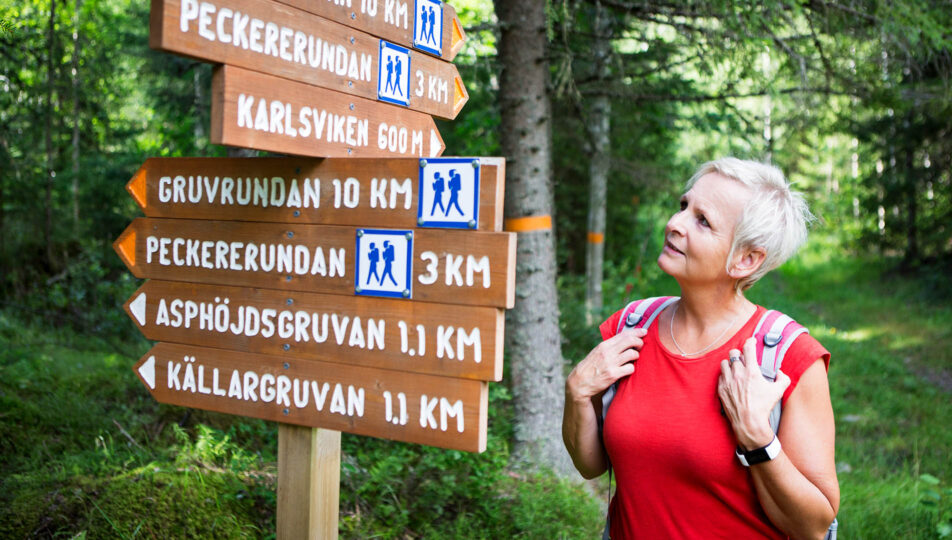Gruvrundan
Welcome to Gruvrundan, one of the most popular hiking trails in Värmland. The trail is 10 kilometers long and offers a perfect blend of nature experiences and cultural heritage remains. The area you are hiking in is about 35 kilometers north-west of Sunne, and here you will also occasionally experience a real wilderness feeling.
Good to Know:
- Trail length: 10 kilometres
- Difficulty level: Difficult
- Distance to Sunne: 37 kilometres
- Starting point: Asphöjdens parking spot >
Exciting history at the old mining area
The trail stretches across the mining area in Mangen, which lies between the Mången and Trehörningen lakes. The mining operations here lasted from the 16th century to the beginning of the 20th century. The hyperite rock base favours a rather special and unusual flora, with several rare species. The trail runs mostly through woodland.

Remains from the industrial past
Along the Gruvrundan trail there are numerous remains from iron mills, concentration plants, mines, transport cable cars for ore, rock piles and a soapstone quarry. Remains from this period also include stone foundations of buildings and a number of iron structures. The forest Finns who settled here in the early 16th century probably also contributed to the labour force in the firing and ore mining work, but also provided the mines with wood for firing in the mines.

Gruvrundan starts at the Asphöjden parking spot
The best place to start hiking the Gruvrundan trail is at the Asphöjden turning area. There is also an information board situated here. You can choose between a 10km or a 3km hike. You can also start your hike at Storgruvan or from Fredros, where you can park in the turning area by the path to Kattgruvan.
Remains of a cable railway
If you start your hike at the Asphöjd carpark and walk north towards Karlsviken you will follow part of the old cable car route. At the beginning, you pass a suspended transport basket. It is one of the many baskets that transported ore from the Storgruvan, a whole kilometer down to the industrial area at Karlsviken.
The story of the infamous Peckerud boy
When you reach Karlsviken, you will find an information board and a picnic table, in addition to the industrial remains. Here you can also see the great stone that, according to local legend, the Peckerud boy rolled into the stream as a stepping stone when he was going to bring home a heifer from the forest. The stone is nearly three meters long and has a mass of about half a cubic meter.
Large and very strong
At Pickerud, the path runs across the grounds of the old croft and the foundations of the old house are directly above the path. This is where the Peckerud boy, who was actually called Nils Olsson, lived. He lived between 1826 and 1896, and was widely known for his tremendous strength. He was extremely tall and was said to have size 54 in shoes. A pair of them are still preserved at the local history museum in Gräsmark. When the people of Värmland went to Bergslagen looking for work, travelling by horse and cart, the Peckerud boy pulled his own cart, as he did not own a horse. The wagons were often heavily loaded, up to 2 1/2 lispounds (425 kg).
The adventures of the Peckerud boy in Stockholm
During a stay in Stockholm, some hoodlums got a little too familiar, and despite the warnings of the Peckerud boy, refused to leave him alone. He therefore hit back and one of the men died. The Peckerud boy was arrested, but King Charles XV promised impunity if he left the city and remained in his local area among the people who knew him.
The blue rock walls of Källargruvan mine
Take the opportunity to make a small stop when passing Källargruvan, “the cellar mine”. There are plenty of rock piles here. A fence surrounds a ten-meter deep mine shaft with water at the bottom. On the southern edge there is a cave-like open-pit quarry where you can see beautiful turquoise shades in the walls.
Fairytale wood at Tiskaretjärnsskogen
The Gruvrundan hiking trails pass through the beautiful Tiskaretjärnsskogen. It is the largest forest that the Swedish Church has voluntarily set aside in Värmland. After the storm in 1969, many large coarse trees in the forest were blown down, and it was later decided that no reprocessing would be done, but that the 32 hectare forest would be set aside as a key biotope. Here you can encounter both capercaillie and hazel grouse, as well as the three-toed woodpecker. On the ground there are blue anemones, creeping lady’s tresses and white baneberry. Many of the trees here have an impressive size.
Feel the wingbeats of history at Storgruvan
After about a mile of hiking between the pillars of trees in the mighty forest, you will reach the Storgruvan mine. There are remains here from the huge plant that was used for the transportation of iron ore, before the 20th century. There are also lots of rock piles. A large mine entrance with braces opens up before you, but entering it is risky; there are rock falls in there that sometimes can be heard as a mighty din. The path stretches more than 70 meters into the mountain.
Inn for the miners
Now there is silence here, but once upon a time the area was filled with the sounds of the industry. The nearby Asphöjden farm also houses the old foundation of an inn where the workers at the Storgruvan lived. There was a telephone line here as early as 1899, which extended to the managing director’s house on the other side of lake Mangen. The telephone was invented in the 1870s, so at Mangen’s mining area they were ahead of the times.


